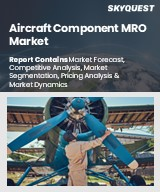
|
시장보고서
상품코드
1383250
세계의 발사체용 아비오닉스 시장(2023-2033년)Global Launch Vehicle Avionics Market 2023-2033 |
||||||
발사체에 탑재되어 미션의 모든 단계에서 유도, 항법, 제어(GNC), 통신 등을 담당하는 전자 시스템 및 부품을 발사체 항공전자라고 합니다. 이러한 항공전자시스템은 성공적인 발사와 페이로드를 원하는 궤도에 올려놓는 데 있어 매우 중요한 역할을 합니다.
비행 컴퓨터는 항공 전자 시스템의 중앙 처리 장치로서 계산, 제어 알고리즘을 실행하고 서로 다른 하위 시스템 간의 데이터 교환을 조정하는 역할을 합니다. 또한 센서 데이터 처리, 궤도 계산, 액추에이터 제어와 같은 작업을 실시간으로 처리하며, GNC 시스템은 발사된 로켓의 위치, 속도, 자세를 결정하고 궤도를 제어합니다. 일반적으로 가속도계, 자이로스코프, GPS 수신기 등의 센서로 구성되며, 내비게이션 알고리즘에 입력 값을 제공합니다.
정확한 궤도와 임무 목표를 보장하기 위해 GNC 시스템은 추력 벡터 제어 및 조향과 같은 발사 로켓 제어를 위한 최적의 명령을 계산합니다. 임무 중 발사 로켓은 기체 상태, 센서 측정값, 원격 측정 데이터 등 많은 양의 데이터를 생성합니다. 텔레메트리 시스템은 발사체의 데이터를 수집, 처리하여 지상 관제 센터로 전송함으로써 발사체의 성능을 실시간으로 모니터링하고 분석할 수 있습니다.
임무를 수행하는 동안 발사 로켓은 기체 상태, 센서 측정값, 원격 측정 데이터 등 많은 양의 데이터를 생성합니다. 원격 측정 시스템은 발사체에서 지상 관제 센터로 데이터를 수집, 처리 및 전송하여 발사체 성능을 실시간으로 모니터링하고 분석할 수 있도록 합니다. 발사 로켓의 전자 장비는 안정적이고 효율적인 전력 공급이 필요합니다.
배전 및 관리 시스템은 다양한 하위 시스템에 전력을 분배하고 각 구성 요소에 적절한 전압과 전류가 공급되도록 하는 역할을 합니다. 이러한 시스템에는 종종 백업 전원 공급 장치, 전압 조정 및 오류 보호 메커니즘이 포함됩니다. 항공전자 시스템은 다양한 센서를 사용하여 발사 로켓의 성능과 환경에 대한 정보를 수집합니다. 가속도계, 자이로스코프, 고도계, 압력 센서, 온도 센서, 자세 결정 센서 등이 이러한 센서의 예입니다. 이러한 센서의 데이터는 실시간 제어, 모니터링 및 안전 평가에 사용됩니다. 항공전자 소프트웨어는 발사 로켓의 동작을 제어하고, 데이터를 처리하고, 유도 제어 기능을 수행하는 임베디드 소프트웨어와 알고리즘으로 구성됩니다. 신뢰성과 견고성을 보장하기 위해 소프트웨어 개발에는 엄격한 테스트, 검증 및 타당성 확인이 포함됩니다.
항공전자 시스템은 추진 시스템, 구조 시스템, 페이로드 시스템 등 발사체 로켓의 다른 하위 시스템과 원활하게 통합되어야 합니다. 항공 전자공학과 다른 구성 요소 간의 데이터 교환 및 상호 운용성을 위해 인터페이스 표준 및 프로토콜이 설정됩니다.
본 보고서에서는 세계 발사체용 항공전자 시장에 대해 분석했으며, 전체 시장 규모 동향 전망, 지역별/국가별 상세 동향, 주요 기술 개요, 시장 기회 등을 조사하여 전해드립니다.
목차
발사체용 아비오닉스 시장 : 분석 정의
발사체용 아비오닉스 시장 내역
- 컴포넌트별
- 페이로드별
- 지역별
발사체용 아비오닉스 시장 분석(향후 10년간)
발사체용 아비오닉스 시장 테크놀러지
세계의 발사체용 아비오닉스 시장 예측
발사체용 아비오닉스 시장 : 지역별 동향과 예측
- 북미
- 성장 촉진요인 및 억제요인, 과제
- PEST 분석
- 시장 예측과 시나리오 분석
- 주요 기업
- 공급업체 Tier 상황
- 기업 벤치마킹
- 유럽
- 중동
- 아시아태평양
- 남미
발사체용 아비오닉스 시장 : 국가별 분석
미국
- 방위 계획
- 최신 동향
- 특허
- 이 시장의 현재 기술 성숙도
- 시장 예측과 시나리오 분석
- 캐나다
- 이탈리아
- 프랑스
- 독일
- 네덜란드
- 벨기에
- 스페인
- 스웨덴
- 그리스
- 호주
- 남아프리카공화국
- 인도
- 중국
- 러시아
- 한국
- 일본
- 말레이시아
- 싱가포르
- 브라질
발사체용 아비오닉스 시장 : 시장 기회 매트릭스
발사체용 아비오닉스 시장 : 분석에 관한 전문가의 견해
결론
Aviation and Defense Market Reports에 대해
LSH 23.12.04The electronic systems and components installed on a launch vehicle that is responsible for its guidance, navigation, control, and communication during all phases of the mission are referred to as launch vehicle avionics. These avionics systems are critical to the successful launch and delivery of payloads to their desired orbits.
Flight computers serve as the avionics system's central processing units, performing computations, executing control algorithms, and coordinating data exchange between different subsystems. They handle tasks such as sensor data processing, trajectory calculations, and actuator control in real-time. GNC systems oversee determining the position, velocity, and attitude of the launch vehicle, as well as controlling its trajectory. They are typically made up of sensors like accelerometers, gyroscopes, and GPS receivers that provide input to navigation algorithms.
To ensure precise trajectory and mission objectives, the GNC system calculates optimal commands for vehicle control, including thrust vector control and steering. During a mission, launch vehicles generate massive amounts of data, including vehicle health status, sensor measurements, and telemetry data. Telemetry systems collect, process, and transmit data from the launch vehicle to the ground control center, allowing for real-time monitoring and analysis of the launch vehicle's performance.
During a mission, launch vehicles generate massive amounts of data, including vehicle health status, sensor measurements, and telemetry data. Telemetry systems collect, process, and transmit data from the launch vehicle to the ground control center, allowing for real-time monitoring and analysis of the launch vehicle's performance. Avionics on launch vehicles require a dependable and efficient power supply.
Power distribution and management systems are in charge of distributing electrical power to various subsystems and ensuring that each component receives the proper voltage and current. These systems frequently include backup power sources, voltage regulation, and fault protection mechanisms. Avionics systems use a variety of sensors to collect information about the launch vehicle's performance and the environment. Accelerometers, gyroscopes, altimeters, pressure sensors, temperature sensors, and attitude determination sensors are examples of these sensors. These sensors' data is used for real-time control, monitoring, and safety evaluations. Avionics software consists of embedded software and algorithms that control the launch vehicle's operations, process data, and perform guidance and control functions. To ensure reliability and robustness, software development includes rigorous testing, verification, and validation.
Avionics systems must be seamlessly integrated with the launch vehicle's other subsystems, such as propulsion, structures, and payload systems. To enable data exchange and interoperability between avionics and other components, interface standards and protocols are established.
Table of Contents
Launch Vehicle Avionics Market Report Definition
Launch Vehicle Avionics Market Segmentation
- By Component
- By Payload
- By Region
Launch Vehicle Avionics Market Analysis for next 10 Years
- The 10-year access control market analysis would give a detailed overview of access control market growth, changing dynamics, technology adoption overviews and the overall market attractiveness is covered in this chapter.
Market Technologies of Launch Vehicle Avionics Market
- This segment covers the top 10 technologies that is expected to impact this market and the possible implications these technologies would have on the overall market.
Global Launch Vehicle Avionics Market Forecast
- The 10-year access control market forecast of this market is covered in detailed across the segments which are mentioned above.
Regional Launch Vehicle Avionics Market Trends & Forecast
- The regional access control market trends, drivers, restraints and Challenges of this market, the Political, Economic, Social and Technology aspects are covered in this segment. The market forecast and scenario analysis across regions are also covered in detailed in this segment. The last part of the regional analysis includes profiling of the key companies, supplier landscape and company benchmarking. The current market size is estimated based on the normal scenario.
- North America
- Drivers, Restraints and Challenges
- PEST
- Market Forecast & Scenario Analysis
- Key Companies
- Supplier Tier Landscape
- Company Benchmarking
- Europe
- Middle East
- APAC
- South America
Country Analysis of Launch Vehicle Avionics Market
- This chapter deals with the key defense programs in this market, it also covers the latest news and patents which have been filed in this market. Country level 10 year market forecast and scenario analysis are also covered in this chapter.
US
- Defense Programs
- Latest News
- Patents
- Current levels of technology maturation in this market
- Market Forecast & Scenario Analysis
- Canada
- Italy
- France
- Germany
- Netherlands
- Belgium
- Spain
- Sweden
- Greece
- Australia
- South Africa
- India
- China
- Russia
- South Korea
- Japan
- Malaysia
- Singapore
- Brazil
Opportunity Matrix for Launch Vehicle Avionics Market
- The opportunity matrix helps the readers understand the high opportunity segments in this market.
Expert Opinions on Launch Vehicle Avionics Market Report
- Hear from our experts their opinion of the possible analysis for this market.



















